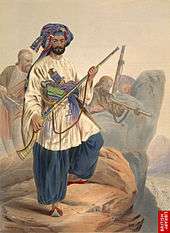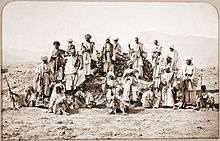Jezail
The jezail or jezzail /Pashto: جزائل, ultimately from the plural form Arabic: جزایل "long [barrels]") was a simple, cost-efficient and often handmade long arm commonly used in British India, Central Asia and parts of the Middle East in the past. It was used amongst the Pashtun (ethnic Afghan) tribesmen fighting independently against the British and Indian soldiers in the Anglo-Afghan wars.
Features

Jezails were generally handmade weapons used by the Pashtun (Ethnic Afghan) tribesmen whilst fighting against the British Indian Empire and their occupation of Pashtun Homeland in Afghanistan. Jezails were seen as very personal weapons, and unlike the typical military weapons of the time which were very plain and utilitarian, jezails tended to be well crafted and were usually intricately decorated.
Jezails tended to have very long barrels. Such lengths were never common in European rifles (with the exception of the Spanish "espingarda" (es) circa 15th century), but were more common in American rifles, such as the Kentucky Rifle. The American rifles were used for hunting, and tended to be of a smaller caliber (.35 to .45 or so being typical). Jezails were usually designed for warfare, and therefore tended to be of larger calibers than the American rifles, with .50 to .75 caliber and larger being common. Larger calibers were possible because the long length of the typical jezail meant that it was heavier than typical muskets of the time. Jezails typically weighed around 12 to 14 pounds, compared to 9 to 10 pounds for a typical musket. The heavy weight of the jezail allowed the rifle itself to absorb more energy from the round, imparting less recoil to the weapon's user.
Many jezails were smooth bore weapons, but some had their barrels rifled. The rifling, combined with the barrel's long length, made these weapons very accurate for their time.
The firing mechanism was typically either a matchlock or a flintlock. Since flintlock mechanisms were complex and difficult to manufacture, many jezails used the lock mechanism from captured or broken Brown Bess muskets.
The stocks were handmade and ornately decorated, featuring a distinctive curve which is not seen in the stocks of other muskets. The function of this curve is debated; it may be purely decorative, or it may have allowed the jezail to be tucked under the arm and cradled tightly against the body, as opposed to being held to the shoulder like a typical musket or rifle. The argument against this method of firing is that the flash pan would be dangerously close to the face and the weapon would be harder to aim. It is more likely that the rifle was only tucked under the arm whilst riding a horse or a camel. The curve may also have saved weight; by shaving away some of the heavy wood used for the stock through employment of the new curved shape, whilst maintaining the same structural integrity of the stock it could still be fired from the shoulder safely whilst also being lighter. The weapon was fired by grasping the stock near the trigger, like a pistol, while the curved portion is tucked under the shooter's forearm, allowing the rifle to be fired with one hand while mounted.
Jezails were often fired from a forked rest, or a horn or metal bipod.
Anglo-Afghan Wars

During this period, the jezail was the primary ranged weapon of the Pashtun tribesmen and was used with great effect against British troops.[2] British Brown Bess smoothbore muskets were effective at no more than 150 yards, and not accurate beyond 50 yards. Because of their advantage in range, Pashtun rebels typically used the jezail from the tops of cliffs along valleys and defiles during ambushes. This tactic repeatedly devastated the British during their doomed 1842 retreat from Kabul to Jalalabad. Despite the advantages over the Brown Bess, British forces were typically able to defeat jezail armed Pashtuns when they fought on relatively flat terrain.
In the First Anglo-Afghan War the British established a cantonment outside of Kabul with dirt walls approximately waist high. Surrounding the cantonment were several abandoned forts which, although out of range of British muskets, were close enough for jezail fire. When ghazi and other Pashtuns forces besieged Kabul and the cantonment, they occupied the forts and used them to snipe British forces from a safe range.
A description from the British Library dating to the First Anglo-Afghan War:
Afghan snipers were expert marksmen and their juzzails fired roughened bullets, long iron nails or even pebbles over a range of some 250 metres. The Afghans could fling the large rifles across their shoulders as if they were feathers and spring nimbly from rock to rock. They loved to decorate their rifles: [Lieutenant James] Rattray writes of finding one adorned with human teeth.[3]
In British literature
The jezail is most notable, at least in Western literature, as the weapon which wounded Dr. Watson—the fictional biographer of the fictional detective Sherlock Holmes—in the Battle of Maiwand during his military service in Afghanistan. In A Study in Scarlet, Watson mentions being wounded in the shoulder.[4] However, in The Sign of the Four, Watson gives the location of the wound as in his leg.[5] In "The Adventure of the Noble Bachelor" Watson refers to the Jezail bullet being "in one of my limbs." These discrepancies have caused debate by Sherlock Holmes fans about which of these locations is the "correct" location of the wound.
The jezail is mentioned repeatedly in some of Wilbur Smith's books, most notably "Monsoon". It was also mentioned in the George MacDonald Fraser adventure Flashman, whose protagonist describes the awful slaughter of British Army troops retreating from Kabul to Jalalabad by Pashtun jezailchis.
It appears in Rudyard Kipling 1886 poem Arithmetic on the Frontier, where the low cost of the weapon is contrasted with the relatively expensive training and education of British officers:
- A scrimmage in a Border Station
- A canter down some dark defile
- Two thousand pounds of education
- Drops to a ten-rupee jezail.
Another reference to the jezail occurs in Kipling's novel The Man Who Would Be King, where the Kohat Jezail is mentioned in the same paragraph as the more advanced Sniper and Martini rifles of the British.
P. G. Wodehouse in Jill the Reckless (1920) describes how the character Uncle Chris, in India during his first hill-campaign, would "walk up and down in front of his men under a desultory shower of jezail-bullets".[6]
Contemporary use
The jezail no longer sees widespread use in warfare of any nature. Limited numbers were, however, used by Mujahideen rebels during the Soviet–Afghan War. Derivatives of the jezail, barely recognizable, and usually termed 'country-made weapons', are in use in rural India—especially in the state of Uttar Pradesh.
References
- "'Ko-i-Staun Foot Soldiery in Summer Costume, Actively employed among the Rocks' | Online Collection | National Army Museum, London". collection.nam.ac.uk. Retrieved 2020-07-24.
- "Aga Jan, an officer of the Kohistan rangers; Meer Humzu, trooper of the first regiment, Janbaz cavalry; a serjeant of Affghan infantry; Ahmed Khan, private Kohistan rangers". NYPL Digital Collections. Retrieved 2020-07-24.
- Ko-i-staun foot soldiery in summer costume (lithograph, British Library)
- Doyle, Arthur Conan. A Study in Scarlet, 1887
- Doyle, Arthur Conan. The Sign of the Four, 1890
- Wodehouse, P.G. (1920). "XX, part 3". The Little Warrior.
- Tanner, Stephen, (2002) Afghanistan: A Military History From Alexander the Great to the Fall of the Taliban, Da Capo Press, ISBN 0-306-81233-9
- "Firearms of the Islamic world in the Tareq Rajab Museum, Kuwait" By Robert Elgood
See also
- Kabyle musket a similar North African musket